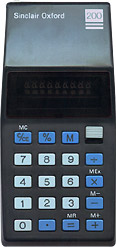|
 The
origin of the Sinclair Oxford was somewhat
unusual. In November 1974 Sinclair, along with
several other companies, was asked to design a
table-top calculator for Gillette, who were at
the time tentatively entering the consumer electronics
market. Sinclair invested a lot of time and effort
in the project but to no avail: Gillette got cold
feet and decided instead to put the whole project
on hold, nervous about economic and pricing uncertainties.
Although the resultant calculator was eventually
released as the Gillette GPA, it was a short-lived
product. The
origin of the Sinclair Oxford was somewhat
unusual. In November 1974 Sinclair, along with
several other companies, was asked to design a
table-top calculator for Gillette, who were at
the time tentatively entering the consumer electronics
market. Sinclair invested a lot of time and effort
in the project but to no avail: Gillette got cold
feet and decided instead to put the whole project
on hold, nervous about economic and pricing uncertainties.
Although the resultant calculator was eventually
released as the Gillette GPA, it was a short-lived
product.
Clive did not let the company's
efforts go to waste, however, particularly as
Gillette had covered the tooling costs (so in
effect, the development was free from Radionics'
point of view). In March 1975 the Sinclair Oxford
range was launched. The three models all used
the same basic case - they could disguished by
their "click-action keys" being "colour-coded
yellow, blue and avocado":
The Oxford 100 was basically
the calculator that had originally been designed
for Gillette. It used a chip brought from General
Instruments but which was fundamentally the same
as that used in the Cambridge. The machine cost
£12.95 + Value Added Tax (VAT, then at 15%).
The Oxford 150 was a
slightly more advanced version, with the ability
to calculate percentages and square roots.
The Oxford 200 had a
memory (a big deal in those days!) and sold for
£19.95 + VAT.
The Oxford 300 was a
scientific model with a limited number of functions
(such as sin, cos, tan etc), which at £29.95
+ VAT set a new price level for this type of calculator.
The Oxford Scientific
was a further development of the 300, with a few
more scientific features.
Unfortunately, the gremlins
in the Sinclair design studio cropped up yet again,
harming the Oxford's chances of being a genuine
pocket (or "briefcase") calculator.
The peak current consumption was 40mA, while the
batteries' recommended maximum was only 10mA.
This tended to drain the batteries very quickly
indeed. Computer Digest magazine recommended
using the PP9 battery instead:
"It's
got the same connections on it and has a recommended
range of 5-50mA. So you won't use it up in record
time. The other point about the PP9 is that
it's 6.6cm x 5.2cm x 8.1cm and weighs close
on one pound. So it would have the added advantage
of making the Oxfords into genuine desk calculators."

Back
to top
|